Epipremnum pinnatum Cebu Blue is a stunning and visually unique plant that has captured the hearts of plant enthusiasts worldwide. Its distinctive silvery blue-green leaves are shaped like stacked arrowheads.
This lovely vine adds an elegant, exotic flair to any space it occupies. Not only is this plant stunning, it is also relatively easy to care for. Just like its close relatives, the pothos plants. This plant is an excellent choice for beginners and experienced plant owners alike.
In this post, we’ll dive into everything you need to know about Epipremnum pinnatum, including its origins, care tips, and some fun facts about this fascinating plant.
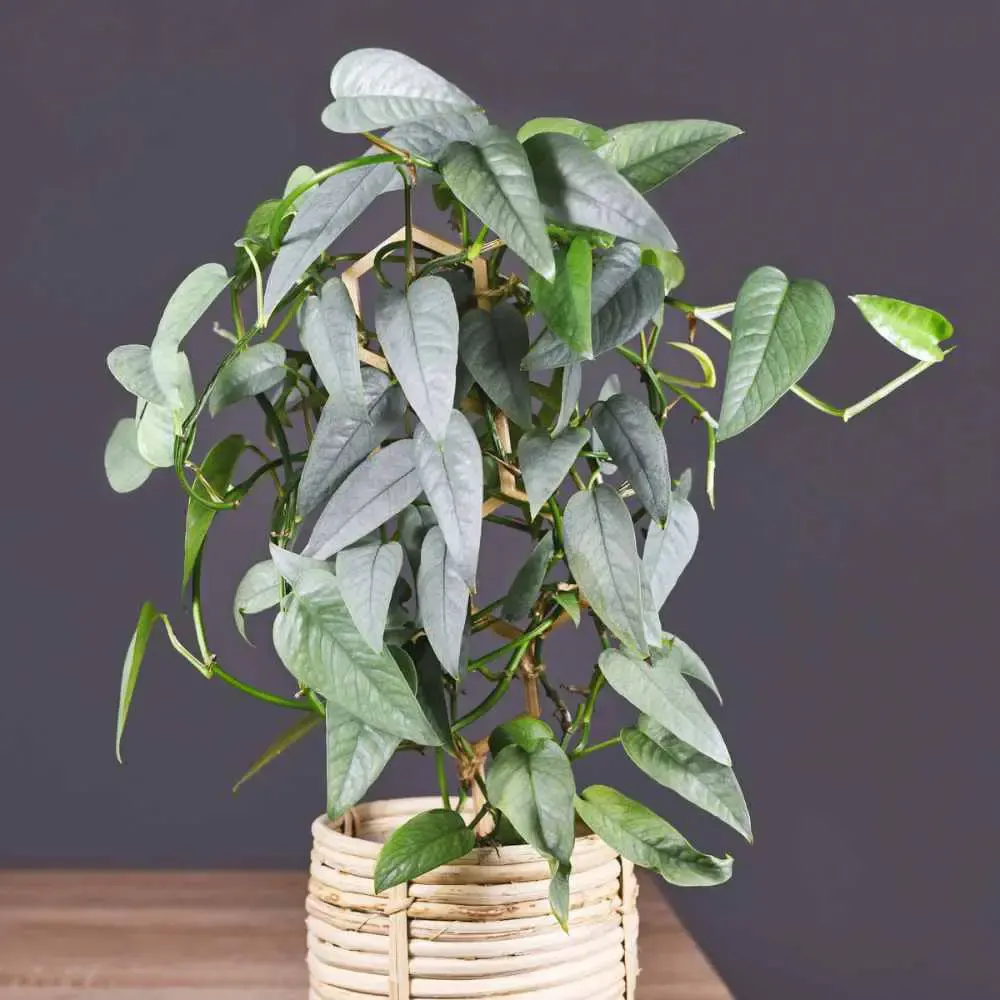
Things to Know About Cebu Blue Pothos:
- Epipremnum pinnatum is native to Southeast Asia, including the Philippines, Malaysia, and Indonesia.
- The plant’s unique blue-green leaves are the result of a waxy coating on the leaves, which helps to protect the plant from excessive sunlight and moisture loss.
- In addition to being a popular houseplant, Epipremnum pinnatum is also used in traditional medicine in some cultures to treat conditions such as asthma and skin infections.
- The plant is known for its air-purifying properties and has been shown to remove toxins such as formaldehyde and benzene from the air.
- Epipremnum pinnatum is a climbing plant and can grow up to 6 feet tall. It produces aerial roots that can attach to surfaces and help the plant climb.
- The plant is toxic to humans and pets if ingested, so it should be kept out of reach of children and animals. The sap can also irritate the skin of some people. So wear gloves when handling it if you are sensitive.
- The Cebu Blue Pothos has a reputation for being a resilient and hardy plant that can tolerate a wide range of growing conditions, including low light and occasional periods of drought.
- Epipremnum pinnatum is closely related to other popular houseplants such as pothos (Epipremnum aureum) and philodendron (Philodendron spp.), and it shares many of the same characteristics and care requirements.

Where to buy Cebu blue?
Is Cebu blue Rare? Well not as much as it used to be but you may have trouble sourcing it in your local garden shop. As time goes on, more large nurseries, like Costa Farms are starting to provide it in their assortment shipments to big box stores. So you may just get lucky.
You can also find it online, and have it shipped, but go to reliable sellers. Esty has a good sellers for this plant. The shop is well rated and has lots of business.
It can also be propagated relatively easily through stem cuttings. So find a plant sale or friend who has one and get a cutting.
Is Cebu Blue fast growing? If provided with bright, indirect light and regular watering, Cebu Blue Pothos can grow quite quickly, producing new leaves and tendrils that can quickly extend several inches or more. It is also a climbing plant and will produce aerial roots that can attach to surfaces and help the plant climb upward.
Regular pruning can help to control the plant’s growth and prevent it from becoming too leggy or unruly. This fast-growing plant adds a lot of visual interest to your indoor space in a relatively short amount of time.

Epipremnum Pinnatum dragon tail and Cebu blue plants are not the same. How are they different?
Epipremnum pinnatum ‘Dragon Tail’, which I blogged about last week, and Epipremnum pinnatum ‘Cebu Blue’ are two different cultivars of the same plant species. They are very closely related but they have some distinct differences in their appearance.
Leaf color: The color of the leaves is different between the two cultivars. ‘Dragon Tail’ has dark green leaves with silver variegation on the edges, while ‘Cebu Blue’ has blue-green leaves that are often described as having a “frosted” appearance.
Growth habit: Another difference between the two cultivars is their growth habit. ‘Dragon Tail’ has a more upright growth habit, with leaves that tend to stand more vertically, while Cebu Blue pothos plant has a more trailing growth habit, with leaves that tend to cascade down from the pot.
Both ‘Dragon Tail’ and ‘Cebu Blue’ are cultivars of Epipremnum pinnatum are often confused especially when immature, and will be labeled the same scientific name. The common names are also easily confused in nurseries. So know what you want before you shop. Silver blue green leaves is the Cebu blue. Dark truer green for the Dragons tail.


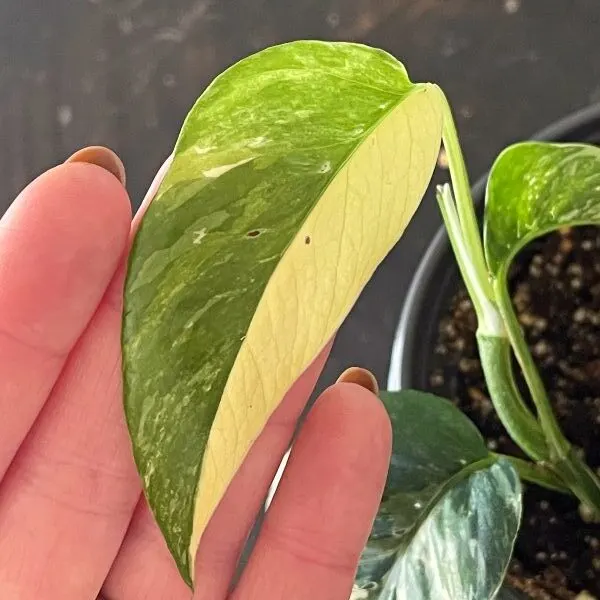
Plants and people go together. Live greenery is therapeutic for humans and Improves our Home Environment.
Like many other pothos plants, Epipremnum pinnatum is known for its air-purifying properties and is often used to improve indoor air quality.
What is So Special About This pothos?
There are a few things that make Cebu Blue Pothos (Epipremnum pinnatum) a special and unique plant:
- Unique appearance: Cebu Blue Pothos has distinctive blue-green leaves that are elongated and shaped like a vine of arrowheads. This gives the plant a unique and exotic appearance that sets it apart from other pothos plants.
- Air-purifying properties: Like many other pothos plants, Cebu Blue Pothos is known for its ability to purify the air by removing toxins such as formaldehyde, benzene, and xylene. This makes it a popular choice for indoor spaces, particularly those with poor air quality.
- Resilience: Cebu Blue Pothos is known for being a resilient and hardy plant that can tolerate a wide range of growing conditions, including low light and occasional periods of drought. This makes it an excellent choice for beginners, or commercial use, or for those who don’t have a lot of time to devote to plant care.
- Easy to propagate: Cebu Blue Pothos is relatively easy to propagate through stem cuttings, which makes it a popular choice for sharing with friends or for expanding your own plant collection.
Is Cebu Blue a Pothos or Philodendron?
Technically neither. Although is is often called by either name. it has its own place in taxonomy.
All cultivars of Epipremnum pinnatum, are members of the family Araceae. They are closely related to both Pothos (Epipremnum aureum) and Philodendron plants. In fact, Cebu Blue Pothos is sometimes also referred to as a Philodendron because of its similarities in appearance and growth habit to certain Philodendron species.
However, taxonomically speaking, Cebu Blue Pothos is considered to be a separate species within the genus Epipremnum. This is because it has several distinctive characteristics that set it apart from both Pothos and Philodendron, such as its unique blue-green leaves and its growth habit, which tends to be more upright and climbing than many other Epipremnum species. So while Cebu Blue Pothos may share some similarities with Pothos and Philodendron, it is a separate and distinct species in its own right.
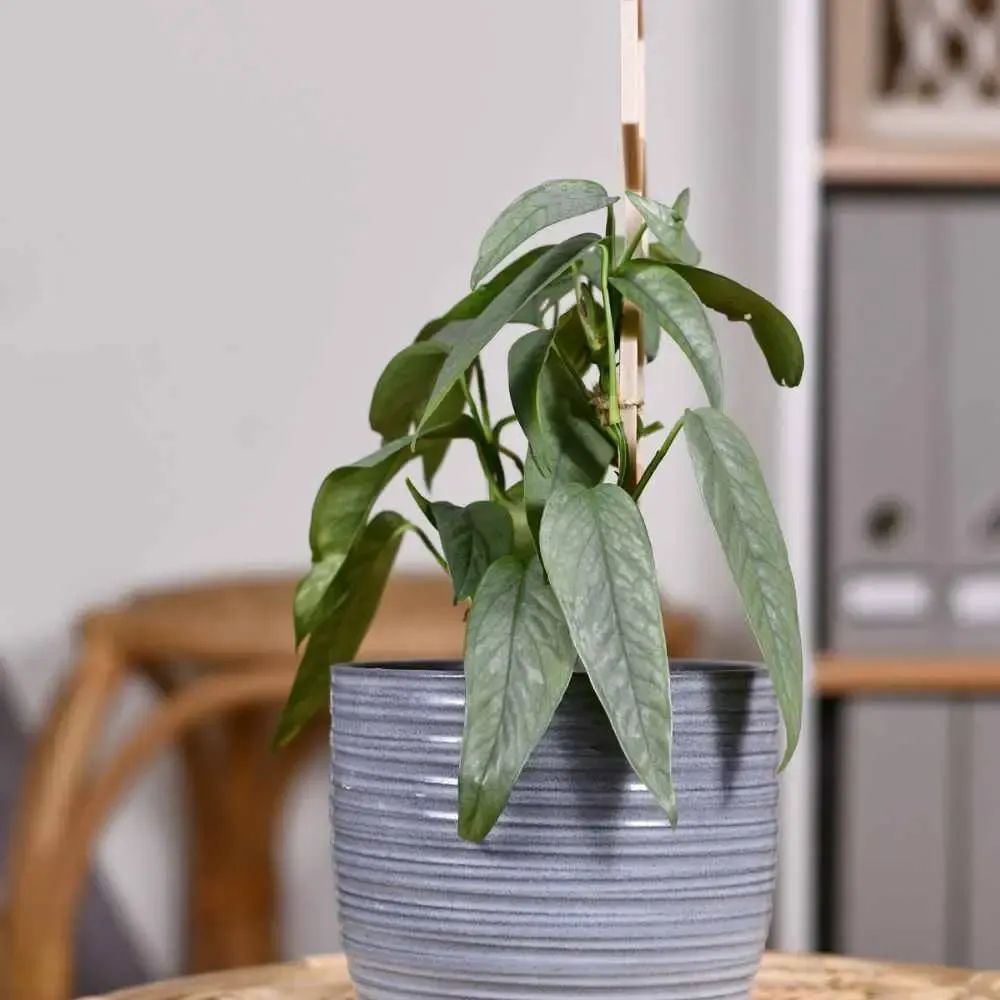
Do Cebu Blue Pothos Climb?
Yes, Cebu Blue Pothos (Epipremnum pinnatum) is a climbing plant and will produce aerial roots that can attach to surfaces and help the plant climb upward. In nature, it can grow up to several meters long and use its aerial roots to climb trees and other structures in search of light.
When grown indoors, Cebu Blue Pothos can be trained to climb a support such as a trellis, moss pole, or wall-mounted trellis. This can help to create a more vertical growth habit and prevent the plant from becoming too leggy or sprawling. If left to grow without support, the plant will still produce trailing stems and tendrils that can add a lot of visual interest to your space.
It’s worth noting that Cebu Blue Pothos can grow quite quickly under the right conditions, so it’s important to keep an eye on its growth and provide regular pruning and support as needed to keep it from becoming too unruly or taking over the space.
Cebu blue Pothos Care:
Here is an ‘at a glance’ table for info on this plant. Below this table is a more detailed plant care guide.
| Familiar Names | Cebu blue pothos, |
| Scientific Name | Epipremnum pinnatum |
| Plant Family | Araceae family |
| Care Difficulty | easy |
| Temperature | 60 to 85 degrees F. |
| Watering | Water Cebu blue plants sparingly. water when soil is dry down and inch or more. Do not overwater or root rot and viral infections can happen. Aroids like this can’t stand wet feet. |
| Humidity | 45% humidity or above is fine for this plant. If you have dry air and leaf tips turn brown, add a pebble tray, do plant grouping or use a small humidifier to moisten the air. |
| Soil | 40% perlite, pumas or other inorganics mixed with a good, slightly acidic potting soil is best for drainage and feeding the plant. |
| Fertilizer | Epipremnum Pinnatum plants also need regular fertilizing to stay healthy. During the growing season (spring and summer), you should feed the plant once a month with a balanced liquid fertilizer. During the winter months, you should cut back on fertilizing and only feed the plant once every two months |
| Lighting | This plant prefers bright, indirect light and can tolerate low light conditions. |
| Growth Habit | Epipremnum pinnatum is a climbing plant and can grow up to 6 feet tall. It produces aerial roots that can attach to surfaces and help the plant climb. |
Epipremnum Pinnatum
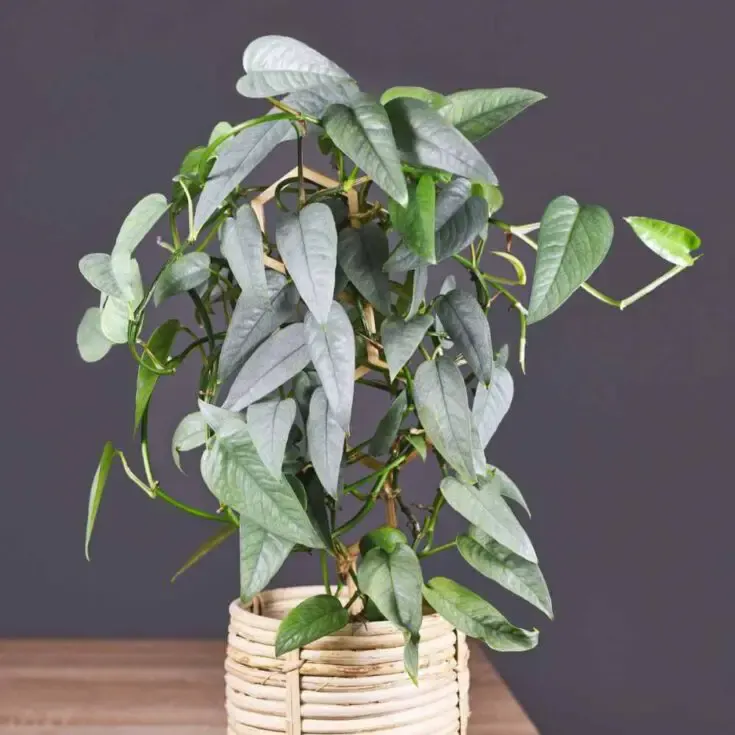
All Pothos have only a few basic requirements to remain a happy durable plant.
This lovely Epipremnum Pinnatum or Cebu Blue vine is a perfect beginner houseplant.
Materials
Instructions
Pothos Soil Preference:
- This aroid requires a light soil.
- A mix of potting soil and perlite will keep the roots happiest.
- Our mix for this pothos is 40 % potting mix to 60% perlite.
- A heavy soil potting mix is not recommended for aroids.
Pot Size and Type:
- Pothos vines can be grown in relatively small pots since they are fairly slow growers.
- If you want to encourage faster growth choose a pot about 2 inches wider in diameter than the current pot.
- Any well drained pot can be used. It MUST have drainage.
- Repot every second year or when roots come out the drainage holes on the pot bottom To the next pot size up.
- Don't jump to a huge pot from a small one unless you wish to encourage faster growth. Just go to the next size up pot.
Pothos Lighting Requirenments:
- The pothos vines enjoy moderate to bright indirect or dappled light. Hover, It will tolerate lower indirect light it if has some brighter moments in the day.
- The variegated types of pothos require more light to show off their colors best.
- Shield this aroid from strong direct light in summer south and west sunny windows. The leaves will burn.
- Tip: Window sheers or blinds can offset some brief periods of high direct light.
How to Water a Pothos:
- Water your Cebu blue pothos when the soil is dry down an inch or so. Give it a good soak so all the soil is moist. Then let the pot completely drain. Pour out any water in the drain plate.
- Aroids do not like to be overly wet. Try a watering schedule of every other week. But let the plant guide you rather than the calandar.
- This tropical plant enjoys humidity. In dry climates this Pothos will thrive with a humidifier nearby. or set it in your kitchen or bathroom. For a really dry climate frequent misting will help.
- In dormant winter months reduce watering to when the soil is dry down halfway .
- Never let this plant get wet feet. If the soil is compacted the bottom of the soil can remain wet which encourages root rot and fungus gnats. If you see yellow leaves on pothos you are probably overwatering.
How to Fertilize a Pothos:
- Apply a good quality fertilizer (linked in materials) monthly through Spring and summer.
- Decrease feedings by late Fall and allow the pothos to rest through the winter months.
- Look for brown spots on the leaves of your plants. This may indicate an over concentration of salts in the roots from over feeding. It can burn the leaves.
- Read Our Post On Fertilizing plants for more information.
Temperature:
- Keep pothos at a low of 65 Degrees F. to upward of 85 Degrees F. It enjoys warmth and humidity.
Pruning and Training:
- Pruning will give you a fuller plant with more even growth. Unpruned pothos will trail.
- Sharp Hand pruners are preferred for pruning. They will give a clean cut that will heal quickly.
- Train your Epipremnum Pinnatum to grow up a spahgmum moss pole for best growth, fenestrated leaves and leaf size. Thye love to grow up!
Table Top Plants:
- It’s easy to prune and shape these plants to whatever length and fullness you desire.
- As a table top plant cut the trailers back evenly all around the pot. If you want the pot fuller add more starts of the neon.
Pests:
- Pothos is not fussy and resists pests. However all plants can get attacked by pests.
- Stress by longterm overwatering, poor light, extreme temperatures and soil conditions are contributors to plant stress..
- Read Our Post on 7 most common plant pests and how to kill them.mites, mealy bugs, spider mites, scale, thrips and whitefly are the most common houseplant pests you will see.
- Read our post on How to get rid of aphids and other pests with our homemade pesticide soap recipe or neems oil.
- To minimize the possibility of pests be sure to check all nursery plants before bringing them home.
- Quarantine all new plants until you are sure no pests live in them.
How to Propagate:
- Propagation is easily done through leaf node stem cuttings.
- You need a 3 to 6 inch leaf stem with a couple of nodes and healthy growth.
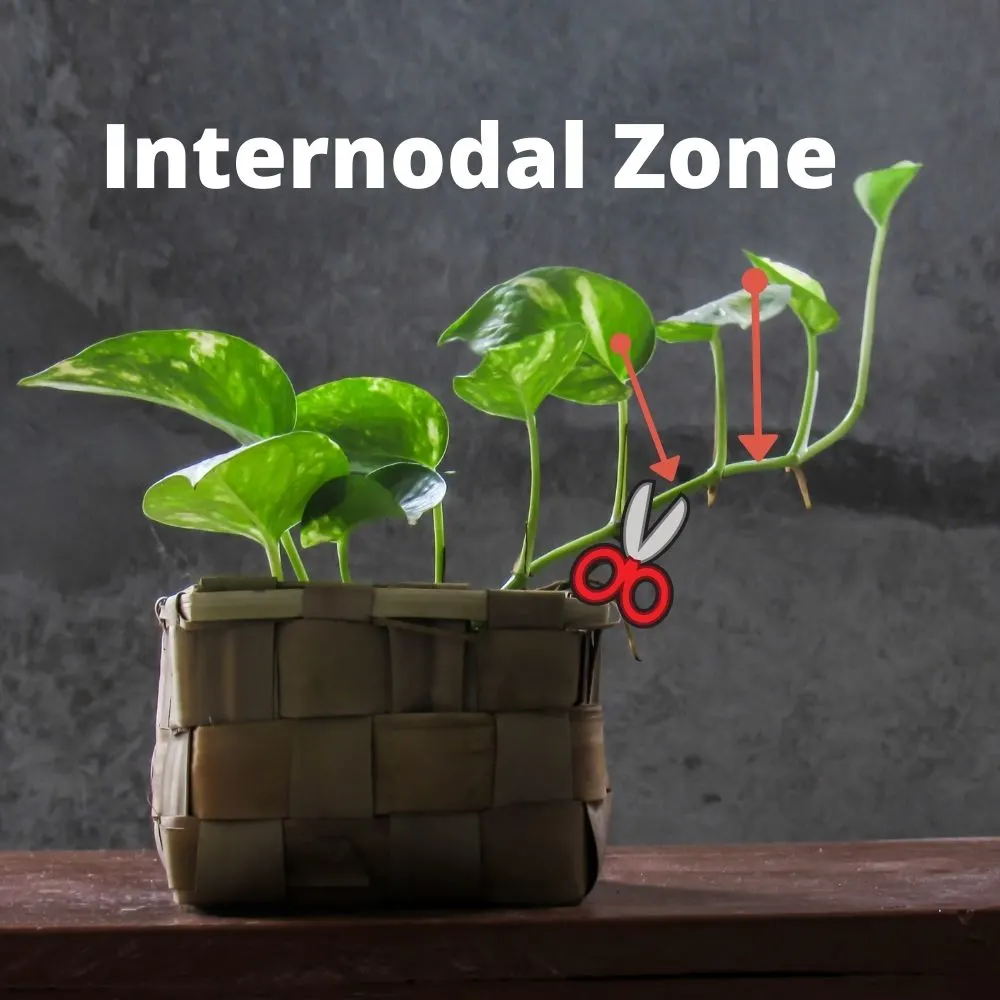
- Place the node into a jar with water. Use tap water that has settled 24 hours in the jar to dissipate chemicals harmful to the neon.
- Set the jar in a well lit area.
- After several weeks roots will grow. Allow the roots to get an inch or more in length.
- Plant gently and firmly into pot with proper soil mix.
- Make sure to keep the soil moist until the roots begin to set into the soil. Be sure to read our post on Propagaing pothos here.
Notes
watch our video below for more on pothos care and propagation.
Trouble Shooting: Why is my Cebu Blue Turning Yellow?
There are several reasons why your Cebu Blue Pothos (Epipremnum pinnatum) leaves may be turning yellow.
- Overwatering: Cebu prefers to be kept on the drier side, and overwatering can lead to root rot and yellowing leaves. Make sure the soil has adequate drainage and allow the soil to dry out slightly between waterings.
- Underwatering: Conversely, underwatering can also cause yellowing leaves. Make sure to water your plant thoroughly when the top inch of soil feels dry.
- Poor soil quality: Cebu Blue Pothos prefer well-draining soil with a slightly acidic pH. If the soil is too compact or alkaline, it can lead to nutrient deficiencies and yellowing leaves.
- Lack of light: Cebu Blue Pothos prefer bright, indirect light. If your plant is not getting enough light, its leaves may start to turn yellow and drop off.
- Temperature stress: Cebu Blue Pothos are tropical plants and prefer warm temperatures between 65-85°F (18-29°C). Exposure to extreme heat or cold can cause stress and lead to yellowing leaves.
- Pest infestations: Infestations of pests such as spider mites, mealybugs, or scale can cause yellowing leaves. Read our post on the seven most common plant pests here. Check your plant regularly for signs of pests and treat them promptly if necessary.
To address the issue of yellowing leaves, you should first identify the underlying cause and adjust your care routine accordingly. Read our Post on Seven Reason Why Your Plant Has Yellowing Leaves for even more ideas on this subject.
Yellow, drooping and browning leaves are signs that something is not going well with your plant. Prune off any yellow or brown leaves, and monitor your plant closely for any further signs of stress. With proper care, your plant should recover and continue to thrive.
Follow Us:
Find us on YouTube, Instagram , Pinterest and TikTok! We love to Plant chat. We also comment, like and occasionally share your content to our daily stories. We’d love to see your plants. Share your joy in your houseplants. Happy Planting!

